Unit 6 Nurturing nature Understanding ideas课件(38页) 2024-2025学年外研版(2019)选择性必修第一册
文档属性
| 名称 | Unit 6 Nurturing nature Understanding ideas课件(38页) 2024-2025学年外研版(2019)选择性必修第一册 | 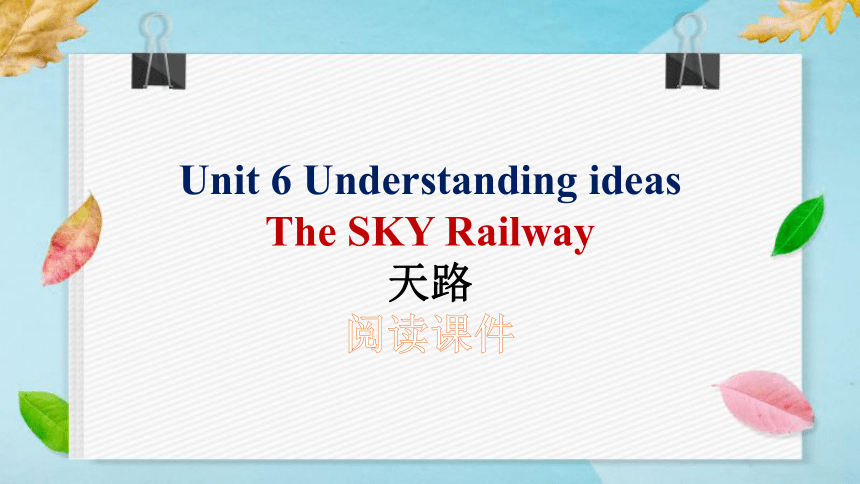 | |
| 格式 | pptx | ||
| 文件大小 | 45.2MB | ||
| 资源类型 | 教案 | ||
| 版本资源 | 外研版(2019) | ||
| 科目 | 英语 | ||
| 更新时间 | 2024-10-10 20:01:35 | ||
图片预览

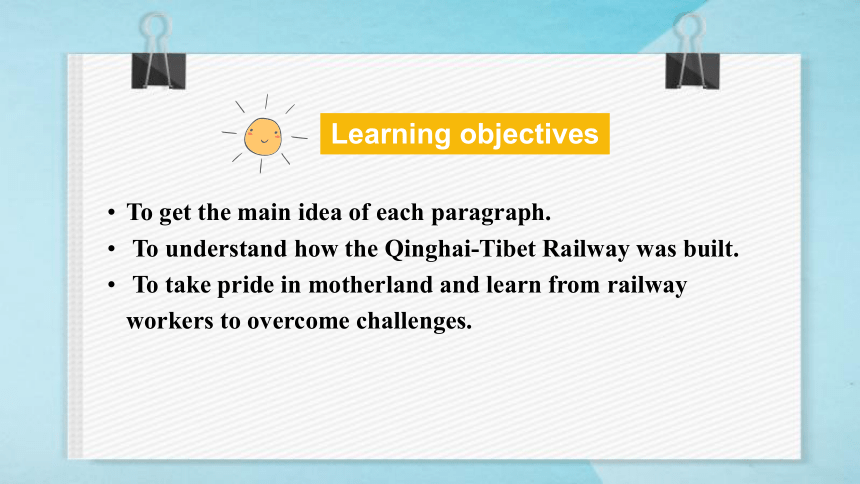
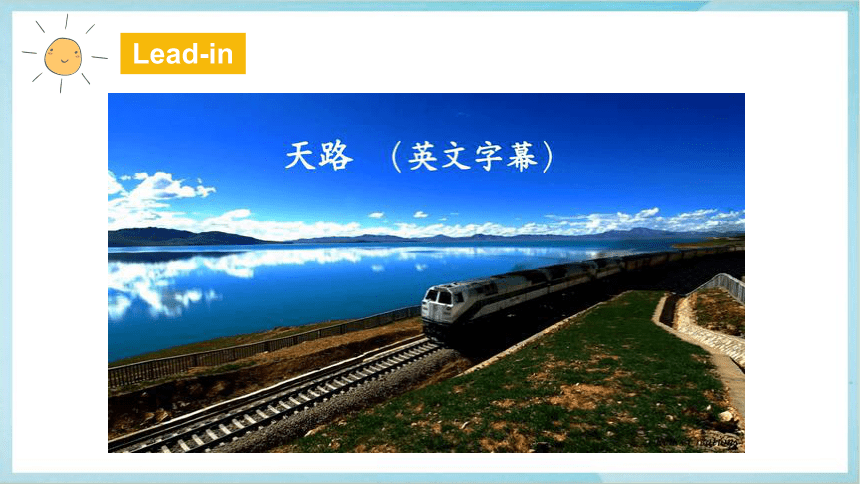
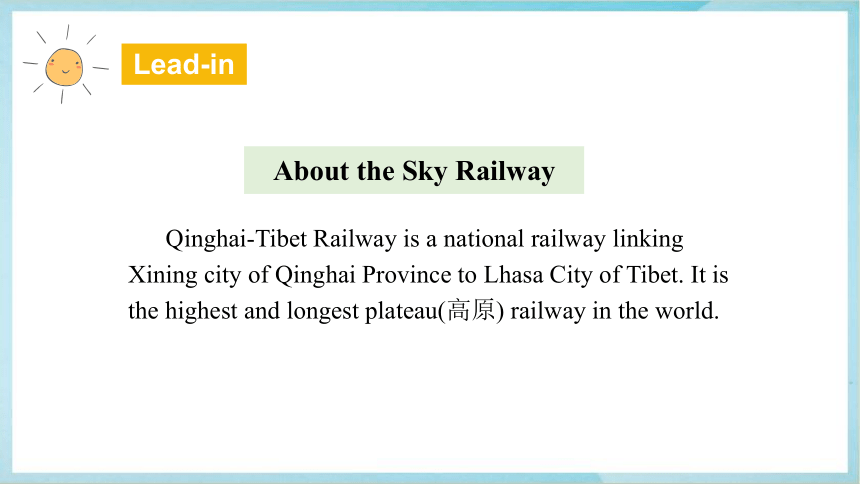
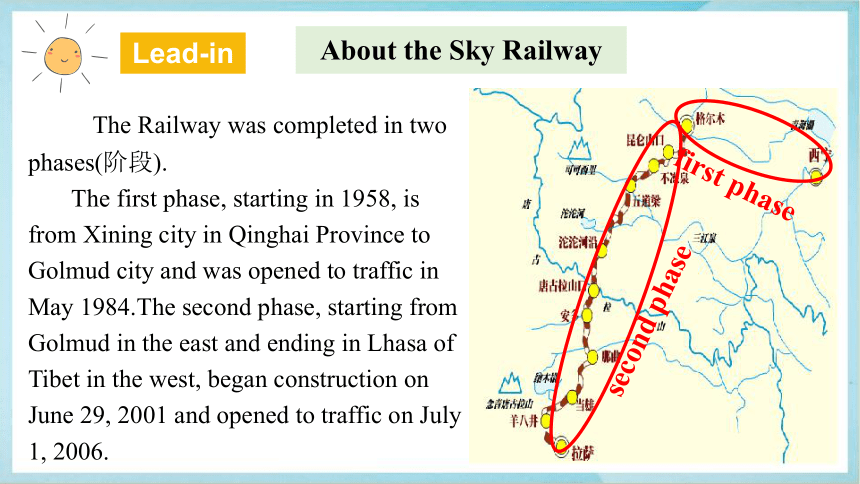
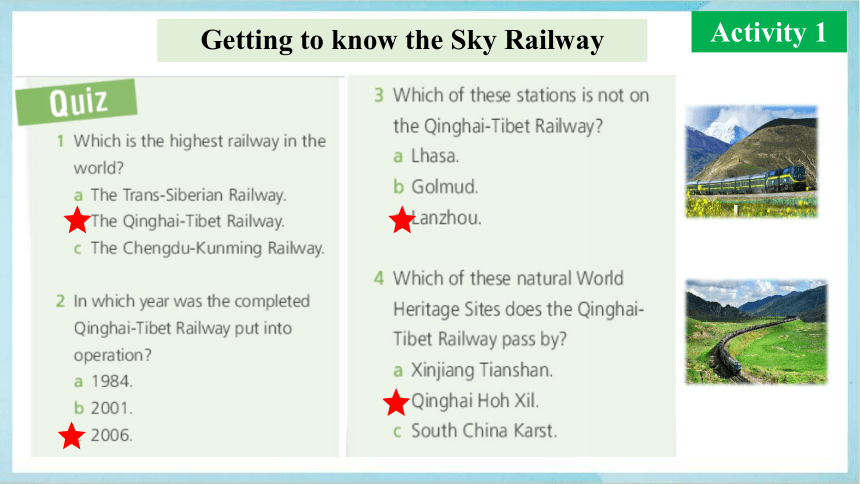
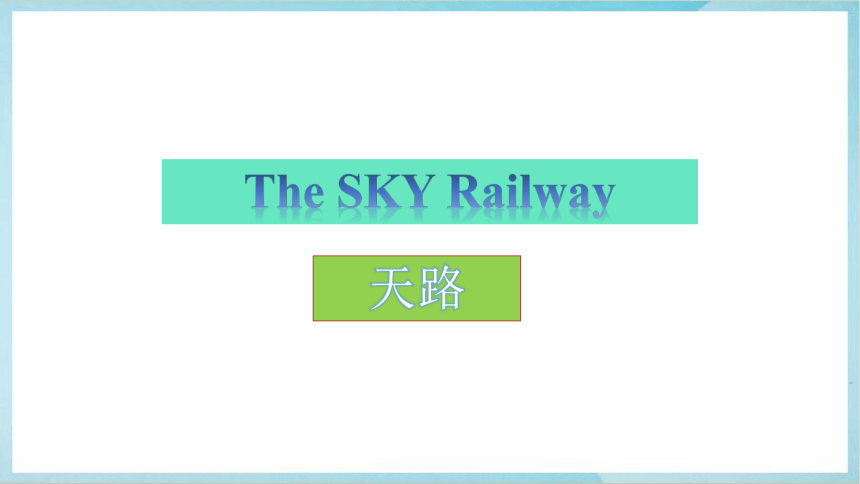
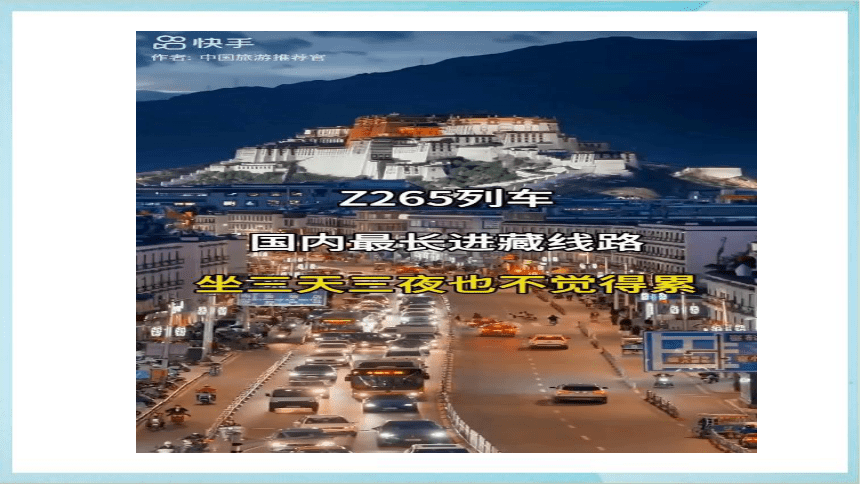
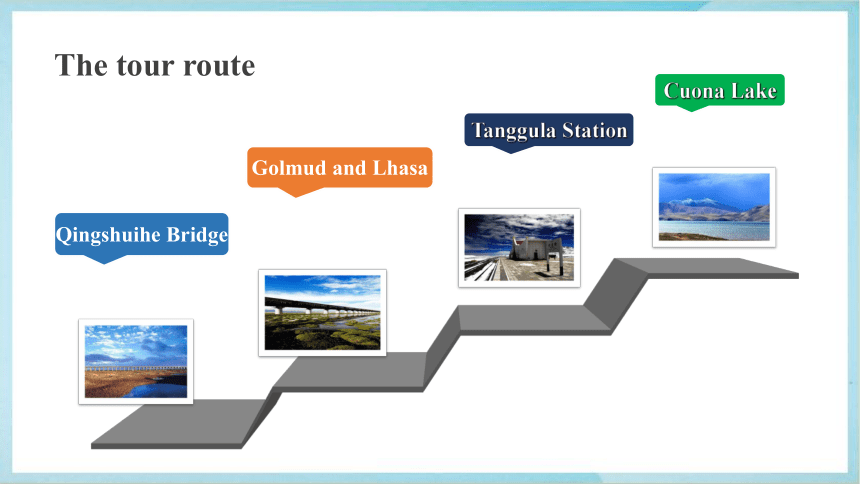
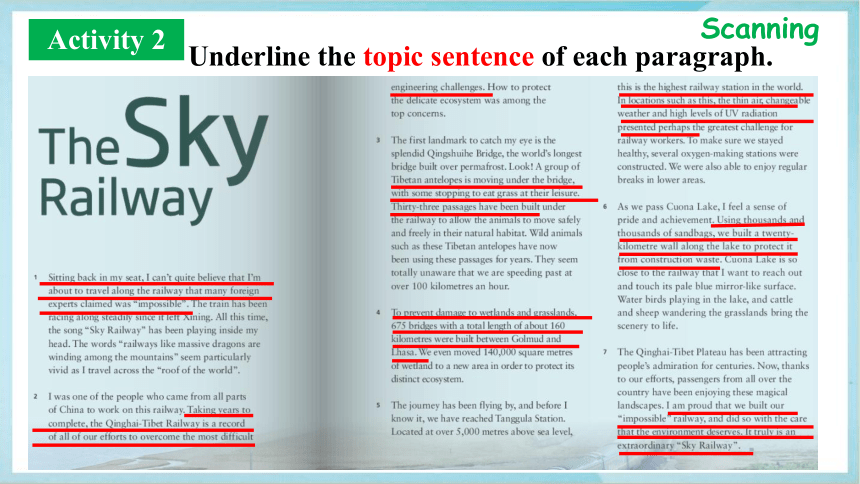
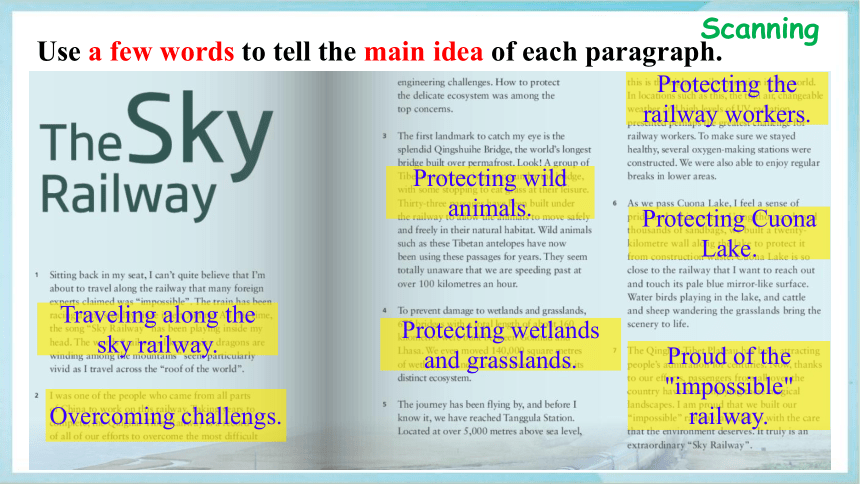
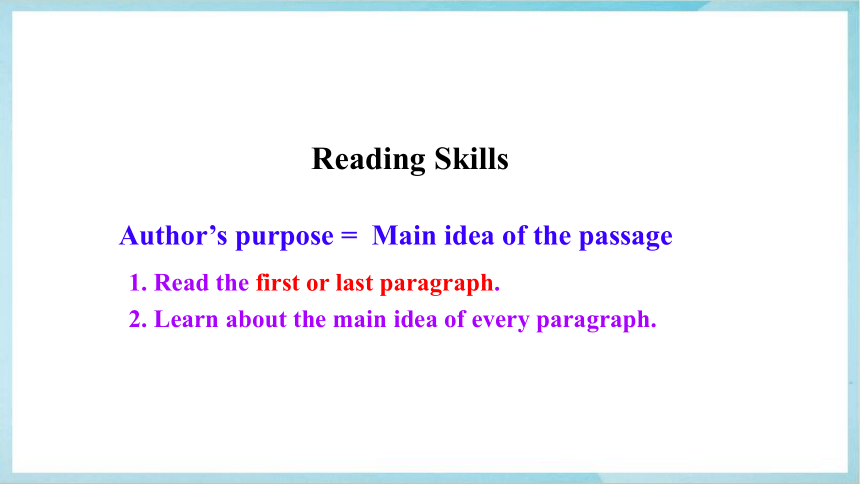
文档简介
(共38张PPT)
Unit 6 Understanding ideas
The SKY Railway
天路
阅读课件
To get the main idea of each paragraph.
To understand how the Qinghai-Tibet Railway was built.
To take pride in motherland and learn from railway workers to overcome challenges.
Learning objectives
Lead-in
Qinghai-Tibet Railway is a national railway linking Xining city of Qinghai Province to Lhasa City of Tibet. It is the highest and longest plateau(高原) railway in the world.
About the Sky Railway
Lead-in
The Railway was completed in two phases(阶段).
The first phase, starting in 1958, is from Xining city in Qinghai Province to Golmud city and was opened to traffic in May 1984.The second phase, starting from Golmud in the east and ending in Lhasa of Tibet in the west, began construction on June 29, 2001 and opened to traffic on July 1, 2006.
About the Sky Railway
Lead-in
first phase
second phase
Getting to know the Sky Railway
Activity 1
The SKY Railway
天路
Qingshuihe Bridge
Golmud and Lhasa
Tanggula Station
Cuona Lake
The tour route
Underline the topic sentence of each paragraph.
Scanning
Activity 2
Use a few words to tell the main idea of each paragraph.
Traveling along the sky railway.
Overcoming challengs.
Protecting wild animals.
Protecting wetlands and grasslands.
Protecting the railway workers.
Protecting Cuona Lake.
Proud of the "impossible" railway.
Scanning
Reading Skills
Author’s purpose = Main idea of the passage
1. Read the first or last paragraph.
2. Learn about the main idea of every paragraph.
Activity 3
According to many foreign experts, __________.
A.it would take a few years to construct the railway.
B.it would need a lot of machines to build the railway.
C.only foreign companies could complete the task.
D.it was impossible to build the railway.
Read paragraph 1
Careful Reading
Why did the author find it hard to believe he was about to travel on this railway
A. Because many foreign experts said it was impossible.
B. Because the journey is very tiring.
C. Because the scenery along the railway is too beautiful.
D. Because they had never ridden on this railway before.
Read paragraph 1
Careful Reading
What can we infer from the second paragraph
A.It took the workers less than a year to complete the railway.
B.The author was among the construction workers of the Qinghai-Tibet Railway.
C.The construction workers paid no attention to ecosystem protection while building the railway.
D.The construction workers didn’t encounter the challenges foreign experts had expected.
Read paragraph 2
Careful Reading
What did the railway workers consider most
A. How to protect the ecosystem along the railway.
B. Their own safety while building the railway.
C. The great number of bridges along the railway.
D.Grasslands and wetlands along the railway.
Read paragraph 2
Careful Reading
The splendid Qingshuihe Bridge 壮观的清水河大桥
What is special about the Qingshuihe Bridge
A. It is the world's longest bridge built over permafrost.
B. It has the most beautiful design.
C. It is the most expensive bridge.
D. It is the first bridge built in that area.
Read paragraph 3
Careful Reading
What are the 33 passages for
A. To allow wild animals to move safely and freely in their natural habitat.
B. For the train to pass through more smoothly.
C. To allow people to walk through and enjoy the scenery.
D. To store equipment and materials for railway maintenance.
Read paragraph 3
Careful Reading
Why were 675 bridges built
A. To show the advanced technology.
B. To protect wild animals.
C. To connect different regions.
D. To prevent damage to wetlands and grasslands.
Read paragraph 4
Careful Reading
Reach Tanggula Station. 到达了唐古拉车站
How did they address the challenges at Tanggula Station
A. By constructing several oxygen-making stations and having regular breaks in lower areas.
B. By building stronger shelters to protect from the weather.
C. By developing special clothing to resist UV radiation.
D. By importing more workers to speed up the work.
Read paragraph 5
Careful Reading
Pass Cuona Lake. 经过措那湖
What was done to protect Cuona Lake
A. Building a wall along the lake.
B. Building a passage along the lake.
C. Building a bridge across the lake.
D. Forbidding building any building along the lake.
Read paragraph 6
Careful Reading
Why did they build a twenty-kilometre wall along the lake
A. To protect it from construction waste.
B. To prevent flooding.
C. To separate the lake from the surrounding area.
D. To prevent wild animals from entering the lake.
Read paragraph 6
Careful Reading
Why has the Qinghai-Tibet Plateau been attracting people's admiration
A. Because of its unique and magnificent landscapes.
B. Because of its high altitude.
C. Because of its abundant wildlife.
D. Because of its historical significance.
Read paragraph 7
Careful Reading
Intensive reading
Challenges
How to protect wild animals?
Solutions
1.________________________ have been built under the railway to allow the animals to 2._____________________________________.
Thirty-three passages
move safely and freely in their natural habitat
Challenges
Solutions
To 3.__________________________
___________________________.
675 bridges with 4._______________________________ were built
between Golmud and Lhasa.
140,000 square meters of wetland were 5.______________________
in order to protect its distinct ecosystem.
prevent damage to wetlands and grasslands
a total length of about 160 kilometres
moved to a new area
Intensive reading
Challenges
Solutions
To make sure the workers stayed healthy.
6.__________________________were
constructed. The workers also enjoyed
7._______________ in lower areas.
Several oxygen-making stations
Regular breaks
Intensive reading
Challenges
Solutions
To 8._________________________.
Thousands and thousands of sandbags were used to 9._______________________ along the lake to 10.____________________________.
protect Cuona Lake
build a twenty-kilometre wall
protect it from construction waste
Intensive reading
Thirty-three passages
move safely and freely in their natural habitat
prevent damage to wetlands and grasslands
a total length of about 160 kilometers
moved to a new area
Several oxygen-making stations
regular breaks
protect Cuona Lake
build a twenty-kilometer wall
protect it from construction waste
Activity 4
1. Which of the solutions are you most impressed by Why
Think and Share
I was most impressed by the first solution. This is because thirty-three passages have been built under the railway to allow the animals to move safely and freely in their natural habitat. This has largely protected the migration routes of wild animals such as Tibetan antelopes and achieved a harmonious unity between human beings and nature.
2. Which words in the passage are used to describe the Qinghai-Tibet Railway What other words could you think of to describe it
These word are used to describe the Qinghai-Tibet Railway: impossible, like massive dragons, Sky Railway. We are proud of it,so we can use words like this:first class, Tibet Railway spirit: "Challenge the limit, brave and first-class" is the general summary of the Qinghai-Tibet railway spirit.
3. What changes do you think the Qinghai-Tibet Railway has brought to the people living along the railway
For the Tibetan people, the Qinghai-Tibet Railway is conducive to improving the transportation network, promoting the economic exchanges between the Qinghai-Tibet region and the coastal areas, promoting the development of resources and materials, promoting the development of tourism, promoting the economic development along the railway, promoting the development of rail-related industries, accelerating the pace of poverty alleviation, consolidating ethnic unity, strengthening national defense and security, and promoting the development of the Qinghai-Tibet Railway.
对藏族人民来说,青藏铁路有利于完善交通网络,促进青藏地区与沿海地区的经济往来,促进资源物资的开发,促进旅游业的发展,促进铁路沿线经济的发展,促进铁路相关产业的发展,加快扶贫步伐,巩固民族团结, 加强国防安全建设,推进青藏铁路建设。
Think and Share
4. What method did you use to collect information How did the information help you to better understand the passage
There are usually four methods of collecting information: interviews, questionnaires, literature reviews, and field observations. Information collection is for a certain purpose to collect relevant original information, should not be excessive collection, to be able to understand the text is appropriate. I like to use the Internet to search for new knowledge in order to better understand the text.
通常有四种收集信息的方法:访谈、问卷调查、文献回顾和实地观察。信息收集是为了一定的目的而收集相关的原始信息,不应过度收集,要以能理解课文为宜。我喜欢利用网络来搜索新的认知,以便更好理解课文。
Think and Share
I was one of the people who work on Qinghai Tibet Railway,1.________ was completed by 2.____________(overcome) the most difficult engineering challenges to protect the delicate ecosystem.To allow animals to move 3._________(safe) and freely,thirty three passages have been built.To prevent damage to wetlands and grasslands,675 bridges,which is about 160 kilometres in 4._______(long),were build and 140,000 square metres of wetland 5.__________ (move) to protect its distinct ecosystem.Tanggula Station,6.________(locate) at over 5,000 metres above sea level,is the highest railway station in the world.To keep us 7._________(health),several oxygen making stations were constructed.To protect Cuona Lake 8.______ construction waste,a twenty kilometre wall was built.Thanks to our efforts,passengers 9.____ have been attracted by the Qinghai Tibet Plateau,have been enjoying these 10.___________(magic) landscapes.
课文语法填空
which
overcoming
safely
length
was moved
located
healthy
from
who
magical
It is said that heaven is not a road, China's railway builders have turned heaven into a road!
都说天路不是路,中国铁路建设者把天堑变通途!
西藏福音
Please write an essay about the difficult challenges China has overcome in the process of building the Qinghai-Tibet Railway and what it means to carry forward the spirit of the railway.
Homework
Unit 6 Understanding ideas
The SKY Railway
天路
阅读课件
To get the main idea of each paragraph.
To understand how the Qinghai-Tibet Railway was built.
To take pride in motherland and learn from railway workers to overcome challenges.
Learning objectives
Lead-in
Qinghai-Tibet Railway is a national railway linking Xining city of Qinghai Province to Lhasa City of Tibet. It is the highest and longest plateau(高原) railway in the world.
About the Sky Railway
Lead-in
The Railway was completed in two phases(阶段).
The first phase, starting in 1958, is from Xining city in Qinghai Province to Golmud city and was opened to traffic in May 1984.The second phase, starting from Golmud in the east and ending in Lhasa of Tibet in the west, began construction on June 29, 2001 and opened to traffic on July 1, 2006.
About the Sky Railway
Lead-in
first phase
second phase
Getting to know the Sky Railway
Activity 1
The SKY Railway
天路
Qingshuihe Bridge
Golmud and Lhasa
Tanggula Station
Cuona Lake
The tour route
Underline the topic sentence of each paragraph.
Scanning
Activity 2
Use a few words to tell the main idea of each paragraph.
Traveling along the sky railway.
Overcoming challengs.
Protecting wild animals.
Protecting wetlands and grasslands.
Protecting the railway workers.
Protecting Cuona Lake.
Proud of the "impossible" railway.
Scanning
Reading Skills
Author’s purpose = Main idea of the passage
1. Read the first or last paragraph.
2. Learn about the main idea of every paragraph.
Activity 3
According to many foreign experts, __________.
A.it would take a few years to construct the railway.
B.it would need a lot of machines to build the railway.
C.only foreign companies could complete the task.
D.it was impossible to build the railway.
Read paragraph 1
Careful Reading
Why did the author find it hard to believe he was about to travel on this railway
A. Because many foreign experts said it was impossible.
B. Because the journey is very tiring.
C. Because the scenery along the railway is too beautiful.
D. Because they had never ridden on this railway before.
Read paragraph 1
Careful Reading
What can we infer from the second paragraph
A.It took the workers less than a year to complete the railway.
B.The author was among the construction workers of the Qinghai-Tibet Railway.
C.The construction workers paid no attention to ecosystem protection while building the railway.
D.The construction workers didn’t encounter the challenges foreign experts had expected.
Read paragraph 2
Careful Reading
What did the railway workers consider most
A. How to protect the ecosystem along the railway.
B. Their own safety while building the railway.
C. The great number of bridges along the railway.
D.Grasslands and wetlands along the railway.
Read paragraph 2
Careful Reading
The splendid Qingshuihe Bridge 壮观的清水河大桥
What is special about the Qingshuihe Bridge
A. It is the world's longest bridge built over permafrost.
B. It has the most beautiful design.
C. It is the most expensive bridge.
D. It is the first bridge built in that area.
Read paragraph 3
Careful Reading
What are the 33 passages for
A. To allow wild animals to move safely and freely in their natural habitat.
B. For the train to pass through more smoothly.
C. To allow people to walk through and enjoy the scenery.
D. To store equipment and materials for railway maintenance.
Read paragraph 3
Careful Reading
Why were 675 bridges built
A. To show the advanced technology.
B. To protect wild animals.
C. To connect different regions.
D. To prevent damage to wetlands and grasslands.
Read paragraph 4
Careful Reading
Reach Tanggula Station. 到达了唐古拉车站
How did they address the challenges at Tanggula Station
A. By constructing several oxygen-making stations and having regular breaks in lower areas.
B. By building stronger shelters to protect from the weather.
C. By developing special clothing to resist UV radiation.
D. By importing more workers to speed up the work.
Read paragraph 5
Careful Reading
Pass Cuona Lake. 经过措那湖
What was done to protect Cuona Lake
A. Building a wall along the lake.
B. Building a passage along the lake.
C. Building a bridge across the lake.
D. Forbidding building any building along the lake.
Read paragraph 6
Careful Reading
Why did they build a twenty-kilometre wall along the lake
A. To protect it from construction waste.
B. To prevent flooding.
C. To separate the lake from the surrounding area.
D. To prevent wild animals from entering the lake.
Read paragraph 6
Careful Reading
Why has the Qinghai-Tibet Plateau been attracting people's admiration
A. Because of its unique and magnificent landscapes.
B. Because of its high altitude.
C. Because of its abundant wildlife.
D. Because of its historical significance.
Read paragraph 7
Careful Reading
Intensive reading
Challenges
How to protect wild animals?
Solutions
1.________________________ have been built under the railway to allow the animals to 2._____________________________________.
Thirty-three passages
move safely and freely in their natural habitat
Challenges
Solutions
To 3.__________________________
___________________________.
675 bridges with 4._______________________________ were built
between Golmud and Lhasa.
140,000 square meters of wetland were 5.______________________
in order to protect its distinct ecosystem.
prevent damage to wetlands and grasslands
a total length of about 160 kilometres
moved to a new area
Intensive reading
Challenges
Solutions
To make sure the workers stayed healthy.
6.__________________________were
constructed. The workers also enjoyed
7._______________ in lower areas.
Several oxygen-making stations
Regular breaks
Intensive reading
Challenges
Solutions
To 8._________________________.
Thousands and thousands of sandbags were used to 9._______________________ along the lake to 10.____________________________.
protect Cuona Lake
build a twenty-kilometre wall
protect it from construction waste
Intensive reading
Thirty-three passages
move safely and freely in their natural habitat
prevent damage to wetlands and grasslands
a total length of about 160 kilometers
moved to a new area
Several oxygen-making stations
regular breaks
protect Cuona Lake
build a twenty-kilometer wall
protect it from construction waste
Activity 4
1. Which of the solutions are you most impressed by Why
Think and Share
I was most impressed by the first solution. This is because thirty-three passages have been built under the railway to allow the animals to move safely and freely in their natural habitat. This has largely protected the migration routes of wild animals such as Tibetan antelopes and achieved a harmonious unity between human beings and nature.
2. Which words in the passage are used to describe the Qinghai-Tibet Railway What other words could you think of to describe it
These word are used to describe the Qinghai-Tibet Railway: impossible, like massive dragons, Sky Railway. We are proud of it,so we can use words like this:first class, Tibet Railway spirit: "Challenge the limit, brave and first-class" is the general summary of the Qinghai-Tibet railway spirit.
3. What changes do you think the Qinghai-Tibet Railway has brought to the people living along the railway
For the Tibetan people, the Qinghai-Tibet Railway is conducive to improving the transportation network, promoting the economic exchanges between the Qinghai-Tibet region and the coastal areas, promoting the development of resources and materials, promoting the development of tourism, promoting the economic development along the railway, promoting the development of rail-related industries, accelerating the pace of poverty alleviation, consolidating ethnic unity, strengthening national defense and security, and promoting the development of the Qinghai-Tibet Railway.
对藏族人民来说,青藏铁路有利于完善交通网络,促进青藏地区与沿海地区的经济往来,促进资源物资的开发,促进旅游业的发展,促进铁路沿线经济的发展,促进铁路相关产业的发展,加快扶贫步伐,巩固民族团结, 加强国防安全建设,推进青藏铁路建设。
Think and Share
4. What method did you use to collect information How did the information help you to better understand the passage
There are usually four methods of collecting information: interviews, questionnaires, literature reviews, and field observations. Information collection is for a certain purpose to collect relevant original information, should not be excessive collection, to be able to understand the text is appropriate. I like to use the Internet to search for new knowledge in order to better understand the text.
通常有四种收集信息的方法:访谈、问卷调查、文献回顾和实地观察。信息收集是为了一定的目的而收集相关的原始信息,不应过度收集,要以能理解课文为宜。我喜欢利用网络来搜索新的认知,以便更好理解课文。
Think and Share
I was one of the people who work on Qinghai Tibet Railway,1.________ was completed by 2.____________(overcome) the most difficult engineering challenges to protect the delicate ecosystem.To allow animals to move 3._________(safe) and freely,thirty three passages have been built.To prevent damage to wetlands and grasslands,675 bridges,which is about 160 kilometres in 4._______(long),were build and 140,000 square metres of wetland 5.__________ (move) to protect its distinct ecosystem.Tanggula Station,6.________(locate) at over 5,000 metres above sea level,is the highest railway station in the world.To keep us 7._________(health),several oxygen making stations were constructed.To protect Cuona Lake 8.______ construction waste,a twenty kilometre wall was built.Thanks to our efforts,passengers 9.____ have been attracted by the Qinghai Tibet Plateau,have been enjoying these 10.___________(magic) landscapes.
课文语法填空
which
overcoming
safely
length
was moved
located
healthy
from
who
magical
It is said that heaven is not a road, China's railway builders have turned heaven into a road!
都说天路不是路,中国铁路建设者把天堑变通途!
西藏福音
Please write an essay about the difficult challenges China has overcome in the process of building the Qinghai-Tibet Railway and what it means to carry forward the spirit of the railway.
Homework
